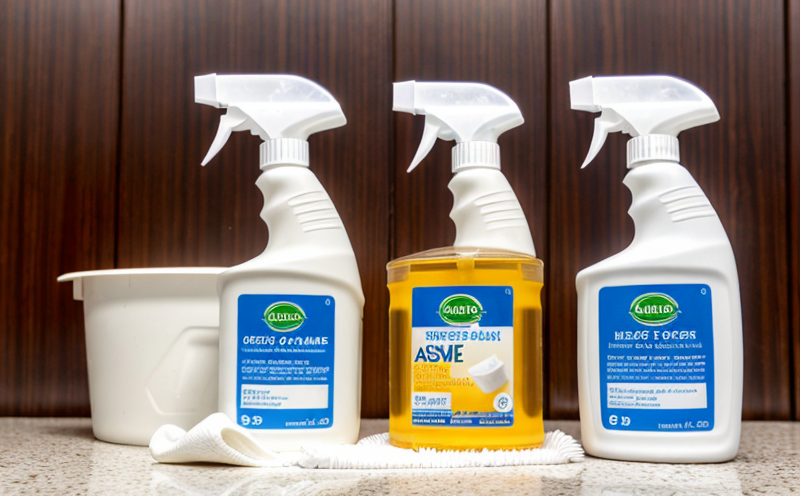EPA 821 Wastewater Cleaning Product Testing
The EPA 821 wastewater cleaning product testing protocol is a critical tool used by manufacturers, environmental engineers, and regulatory bodies to ensure the safety and effectiveness of products designed to reduce contamination in waterways. This testing procedure focuses on cleaning agents intended for use in municipal or industrial waste streams.
Compliance with EPA 821 helps companies avoid penalties associated with illegal discharge into public waters while also protecting human health and aquatic ecosystems from harmful substances that may be present in the wastewater after cleaning product usage. The test evaluates not just the immediate reduction of visible pollutants, but also the long-term impact on water quality.
The EPA 821 protocol is rooted in the belief that effective cleaning products should not only remove contaminants efficiently but should do so without introducing new toxic compounds into the environment or compromising the integrity of the sewage treatment process. This comprehensive approach ensures that the solutions developed are sustainable and environmentally responsible.
To achieve this goal, EPA 821 requires a series of laboratory tests to be conducted under controlled conditions. These tests include:
- Initial pollutant concentration measurement
- Cleaning agent application at specified concentrations
- Incubation period following cleaning product addition
- Post-cleaning water analysis to determine residual pollutants and toxicity levels
- Evaluation of the biodegradability of remaining compounds
The testing process is designed to mimic real-world conditions as closely as possible, which includes varying concentrations of common pollutants found in municipal or industrial wastewater. This ensures that the cleaning product’s performance can be accurately assessed under a range of scenarios.
It's important to note that EPA 821 is not just about removing visible contaminants like oil and grease; it also considers less obvious but equally harmful substances such as heavy metals, organic solvents, and pharmaceutical residues. The protocol aims to ensure that cleaning products are effective against a broad spectrum of pollutants.
For the testing to be valid, strict specimen preparation is necessary. This involves:
- Mixing wastewater samples with specified amounts of cleaning agent
- Adjusting pH levels if required by the protocol
- Ensuring a consistent temperature and incubation period for all specimens
- Sampling at regular intervals to capture changes in pollutant concentrations over time
The instrumentation used in EPA 821 testing is sophisticated and precise. It includes:
- UV-Vis Spectrophotometers for measuring pollutant levels
- Infrared Analyzers to assess chemical composition changes
- Toxicity Testing Kits that use bioassay techniques to evaluate the impact on aquatic life
- Biodegradability Test Systems that monitor how quickly remaining compounds can be broken down by natural processes
The results of EPA 821 testing are reported in a structured manner, detailing:
- Initial pollutant concentrations before and after cleaning product application
- Reduction percentages for each type of contaminant removed by the agent
- Potential toxicity levels post-cleaning as assessed through bioassay tests
- Biodegradability rates of remaining compounds, indicating whether they are environmentally friendly
The comprehensive nature of EPA 821 ensures that cleaning products meet stringent environmental standards while also being effective in real-world applications. Compliance with this protocol is not only a legal requirement but also a testament to the manufacturer’s commitment to sustainability and public health.
Why It Matters
EPA 821 testing is crucial for several reasons:
Environmental Protection: By ensuring that cleaning products do not introduce harmful substances into the water supply, EPA 821 helps protect aquatic ecosystems from contamination.
Public Health: Effective cleaning agents reduce the risk of waterborne diseases by eliminating pathogens and pollutants. This is particularly important in municipal waste systems where public health is a top priority.
Legal Compliance: Failure to comply with EPA 821 can result in significant fines and legal action, making it essential for manufacturers to adhere to these standards.
Sustainable Development: The protocol encourages the development of cleaning products that are environmentally friendly, promoting a sustainable approach to waste management.
Enhanced Reputation: Companies that meet EPA 821 standards enhance their reputation as responsible corporate citizens, which can lead to increased market share and customer loyalty.
Industry Applications
- Municipal Water Treatment Facilities: Ensuring that cleaning products used in municipal systems are effective without causing harm is critical for maintaining water quality.
- Industrial Waste Management: Industries with significant wastewater streams must use EPA 821-compliant products to prevent contamination of local water bodies.
- Hospital and Healthcare Facilities: Cleaning agents used in healthcare settings need to be tested for their environmental impact as well as their efficacy, ensuring patient safety and regulatory compliance.
- Retail and Commercial Cleaning Companies: These companies often use EPA 821-compliant products to ensure they meet the highest standards of cleaning and hygiene without compromising on environmental responsibility.
Quality and Reliability Assurance
The quality and reliability assurance processes for EPA 821 testing are stringent. Laboratories must be accredited to perform these tests, ensuring that the results are accurate and reliable.
Accreditation: Labs must undergo rigorous accreditation processes to ensure they meet international standards such as ISO/IEC 17025 for calibration and testing laboratories. This ensures that all equipment used in the testing process is calibrated correctly and consistently.
Standard Operating Procedures (SOPs): Each laboratory must have detailed SOPs that outline the exact procedures to follow during EPA 821 testing, from specimen preparation to final reporting.
Data Validation: All data collected during EPA 821 testing is subject to rigorous validation processes. This includes double-checking calculations and re-running tests where necessary to ensure accuracy.
Continuous Improvement: Laboratories are encouraged to continuously improve their methods, using feedback from clients and ongoing research to refine the testing process further.





